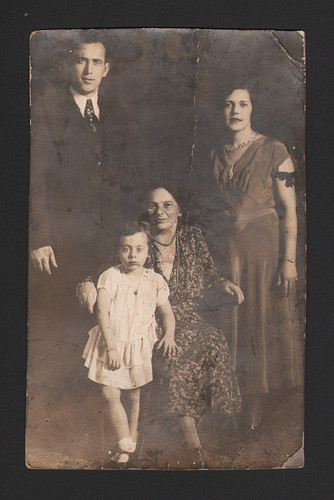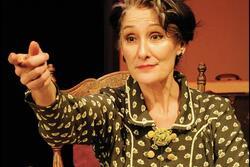The Album as Archive, the Photograph as Story
On Sunday afternoon, twelve women sat around a table at the sunny education center of Mayyim Hayyim, in Newton, Mass. Each of us clutched -- gently, lovingly -- a few old photos, sepia-toned, worn at the edges. These photos held pieces of our history, and as many questions as answers.
We were gathered together for a Jewish Women's Archive workshop (led by me and my colleague, Emily) on "The Album as Archive, The Photograph as Story," held in conjunction with Leslie Starobin's art exhibit. Starobin's collages, which combine photos and artifacts in an artistic rendering of Jewish family stories, provided an evocative backdrop for our exploration of our own family stories.
We began with a close reading of a few of Starobin's striking pieces, considering the juxtaposition of the images and artifacts, as well as the tension between the stories we imagined about the piece and the actual "truth" behind it. Then, in pairs, we turned to our own photographs, taking turns observing the details we saw in each other's photos and imagining what we thought was captured there, before hearing the stories that we each actually knew.
Some people, like Janet Zerlin Fagan, knew a lot about the photos they brought with them. Janet shared a 1932 portrait of her mother, Helen, as a child with her parents, Jules and Sarah, and grandmother, Hinda.
She explains: "They all lived on South Rampart Street in New Orleans. Jules was a tailor and they lived above their shop. Sarah's three siblings all owned and lived in their own tailor shops/clothing stores on South Rampart Street. Hinda periodically lived in each home. Hinda was very gentle and my mother adored her." You can see the love in how Hinda and Sarah lean into each other, and the specific details about the Shlufman family's shops on South Rampart Street makes it clear how this photo also captures a piece of the history of Jewish New Orleans. (You can learn more about Janet's family's New Orleans history in JWA's online collection, Katrina's Jewish Voices.)
Other photos held incomplete stories. Rebecca Sher brought a photo of her Grandma Rae, posing with a book, in an ornate wicker posing chair, for a school graduation portrait at age 7, circa 1918.
Rebecca remembers, as a child, staring at her grandmother's lace-up boots and thinking about how the world was a completely different place when she was a girl. In our conversation about the photo, we wondered together about what kind of school exactly was Rae graduating from? And Rebecca recalled that her grandmother married her grandfather at age 16. How soon after this picture was taking, she mused, did she leave school? What was she thinking about at the time?
Even when we don't have all the details about the photos that have been passed down to us, we feel their personal resonance and significance as family heirlooms and pieces of our past. What we emphasized in the workshop on Sunday is that these family treasures -- like many other personal artifacts of daily life -- are also historically significant, part of larger narratives about Jewish history, immigration, gender relations, education, marriage, and economy, to name a few. From Rebecca's photo, for example, we learn that in 1918, some families valued their daughters' education enough not only to send them to school but also to mark the moment of their graduation at age 7. From Janet's photo, we learn about a family's linked economy in a Jewish neighborhood of New Orleans.
What are your favorite family photos and what stories do they tell?









This article resonated with me, the designated family archivist. I am at this moment moving cartons of 4 generations of photographs to my home in FL. If not for my interest, these family images and history would long ago have been discarded. I can only hope that one of my children, grandchildren, nephews, or their families will treasure family history as I do and continue to save and record. I would love to participate in a workshop to shape this family history. That would make the task less forboding for future archivists than 12 cartons of "stuff".